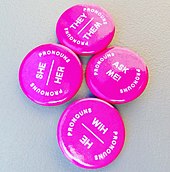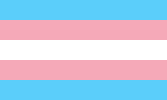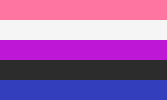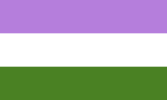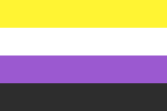Non-binary is a spectrum of gender identities that are not exclusively masculine or feminine—identities that are outside the gender binary. Genderqueer is an earlier term with the same meaning, originating from queer zines of the 1980s. Non-binary identities can fall under the transgender umbrella, since many non-binary people identify with a gender that is different from their assigned sex.
Non-binary people may identify as having two or more genders (being bigender or trigender); having no gender (agender, nongendered, genderless, genderfree or neutrois); moving between genders or having a fluctuating gender identity (genderfluid); being third gender or other-gendered (a category that includes those who do not place a name to their gender).
Gender identity is separate from sexual or romantic orientation, and non-binary people have a variety of sexual orientations, just as cisgender people do.
A non-binary gender is not associated with a specific gender expression, such as androgyny. Non-binary people as a group have a wide variety of gender expressions, and some may reject gender "identities" altogether.
Non-binary people may identify as having two or more genders (being bigender or trigender); having no gender (agender, nongendered, genderless, genderfree or neutrois); moving between genders or having a fluctuating gender identity (genderfluid); being third gender or other-gendered (a category that includes those who do not place a name to their gender).
Gender identity is separate from sexual or romantic orientation, and non-binary people have a variety of sexual orientations, just as cisgender people do.
A non-binary gender is not associated with a specific gender expression, such as androgyny. Non-binary people as a group have a wide variety of gender expressions, and some may reject gender "identities" altogether.
Definitions and identity
Jacob Tobia is a genderqueer writer and activist.
In addition to being an umbrella term, genderqueer has been
used as an adjective to refer to any people who transgress distinctions
of gender, regardless of their self-defined gender identity, or who "queer"
gender. Individuals may express gender non-normatively by not
conforming into the binary gender categories of "man" and "woman". Genderqueer is often used to self-identify by people who challenge binary social constructions of gender.
The term has also been applied by those describing what they see as a gender ambiguity. Androgynous (also androgyne)
is frequently used as a descriptive term for people in this category.
This is because the term androgyny is closely associated with a blend of
socially defined masculine and feminine traits.
However, not all genderqueer people identify as androgynous. Some
genderqueer people identify as a masculine woman or a feminine man or
combine genderqueer with another gender option.
Many references use the term transgender to include genderqueer/non-binary people. The Human Rights Campaign Foundation and Gender Spectrum use the term gender-expansive
to convey "a wider, more flexible range of gender identity and/or
expression than typically associated with the binary gender system".
Genderfluid people often express a desire to remain flexible about their gender identity rather than committing to a single definition.
They may fluctuate between differing gender expressions over their
lifetime, or express multiple aspects of various gender markers at the
same time. They may at times identify as bigender - shifting between masculine and feminine; or as trigender - shifting between these and a third gender.
Agender people ('a-' meaning "without"), also called genderless, genderfree, non-gendered, or ungendered, are those who identify as having no gender or being without a gender identity. Although this category includes a broad range of identities which do not conform to traditional gender norms,
scholar Finn Enke states that people who identify with any of these
positions may not necessarily self-identify as transgender. Agender people have no specific set of pronouns; singular they is typically used, but it is not the default. Neutrois and agender were two of 50 available custom genders on Facebook, which were added on 13 February 2014. Agender is also available as a gender option on OkCupid since 17 November 2014.
Demigender is a gender identity of a person identifying partially or mostly with one gender and at the same time with another gender.
There are several subcategories of the identity. A demi-boy or
demi-man, for example, identifies at least partially with being a boy or a man, no matter the sex and gender they were assigned at birth,
while other parts of their identity might be assigned to other genders,
genderfluid or no other gender (agender). A demiflux person feels that
the stable part of their identity is non-binary.
History
Some constructionist
historians and anthropologists have argued that the binary system of
gender identity can be traced to the 19th century when sexuality was
first medicalized, though others challenge this.
Some constructionists argue that people started to identify as gay when
biological sciences grew in influence, churches became less powerful,
and social and political structure began to change. George Chauncey, professor of history at Yale University, notes that during the early 20th-century gender roles rather than sexual partners were used to determine sexuality.
For instance, "feminine" men who had sex with other men were labeled as
"mollies" or "fairies", whereas masculine men who had sex with other
men remained unlabeled. Historians like David Halperin
argue that by the mid-20th century it became normative for laypeople in
the U.S. to label individuals as either heterosexual or homosexual, while other historians like John Boswell argue that the concepts the words refer to have existed for centuries.
The term genderqueer came into use during the mid-1990s. Riki Anne Wilchins is often associated with the word genderqueer, especially because of her contributions to Genderqueer: Voices Beyond the Sexual Binary which was published in 2002. In 1995 she was also published in the newsletter In Your Face, where she used the term genderqueer.
In the newsletter, the term appears to refer to people with complex or
unnamed gender expressions, which does not match with the general
definition used today. Wilchins stated she identifies as genderqueer in
her 1997 autobiography.
Some genderqueer people are medically treated for gender dysphoria with surgery or hormones, as trans men and women are.
Gender neutrality
Gender neutrality is the movement to end discrimination of gender altogether in society through means of gender-neutral language, the end of sex segregation, and other means.
Pronouns and titles
Pronoun pin badges from a 2016 art and tech festival
Some non-binary/genderqueer people prefer to use gender-neutral pronouns. Usage of singular 'they', 'their' and 'them' is the most common; and ze, sie, hir, co, and ey are used as well. Some others prefer the conventional gender-specific pronouns
'her' or 'him', prefer to be referred to alternately as 'he' and 'she',
or prefer to use only their name and not use pronouns at all. Many prefer additional neutral language, such as the title 'Mx.' instead of Mr. or Ms.
In 2019, they as a non-binary pronoun was added to Merriam-Webster's dictionary.
Legal recognition
In today's society, many non-binary/genderqueer people still use the
gender they were given at birth to conduct everyday business because
many areas of life still conduct business with binary genders. Things
are changing though as more businesses are becoming more accepting of
non-binary genders. Multiple countries legally recognize non-binary or third gender
classifications. Some non-western societies have long recognized
transgender people as a third gender, though this may not (or may only
recently)
include formal legal recognition. In western societies, Australia may
have been the first country to legally recognize third classifications,
following recognition of Alex MacFarlane as having indeterminate sex, reported in 2003.
Discrimination
In the United States, the majority of respondents to the National
Transgender Discrimination Survey chose "A gender not listed here." The
"not listed here" respondents were nine percentage-points (33 percent)
more likely to report forgoing healthcare due to fear of discrimination
than the general sample (36 percent compared to 27 percent). Ninety
percent reported experiencing anti-trans bias at work, and 43 percent
reported having attempted suicide.
Symbols and observances
Anjali Gopalan and Gopi Shankar Madurai inaugurating Asia's first Genderqueer Pride Parade at Madurai with a rainbow and genderqueer flag
Many flags have been used in non-binary and genderqueer communities
to represent various identities. There are distinct non-binary and
genderqueer pride flags. The genderqueer pride flag was designed in 2011
by Marilyn Roxie. Lavender represents androgyny or queerness, white
represents agender identity, and green represents those whose identities
which are defined outside the binary. The non-binary pride flag was created in 2014.
Yellow represents people whose gender exists outside the binary, purple
represents those who feel their gender is a mixture of – or between –
male and female, black represents people who feel as if they have no
gender, and white represents those who embrace many or all genders.
Genderfluid people, who also fall under the genderqueer umbrella,
have their own flag as well. Pink represents femininity, white
represents lack of gender, purple represents mixed gender or androgyny,
black represents all other genders, and blue represents masculinity.
Agender people, who also sometimes identify as genderqueer, have
their own flag. This flag uses black and white stripes to represent an
absence of gender, and a green stripe to represent non-binary genders.
International Non-Binary People's Day is celebrated on 14 July.
Population figures
A 2019 survey of the Two-Spirit and LGBTQ+ population in the Canadian city of Hamilton, Ontario called Mapping the Void: Two-Spirit and LGBTQ+ Experiences in Hamilton showed that 19% of the 906 respondents identified as non-binary.
A 2017 survey of Canadian LGBT+ people called LGBT+ Realities Survey
found that 4% of the 1,897 respondents identified as non-binary
transgender and 1% identified as non-binary outside of the transgender
umbrella.
According to The Report of the 2015 U.S. Transgender Survey, 35% of the nearly 28,000 transgender respondents to the anonymous online survey identified as non-binary.
A 2011 survey conducted by the Equality and Human Rights Commission in the UK found that 0.4% of the 10,039 respondents identified as non-binary.

